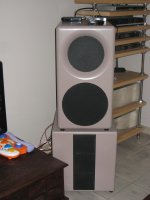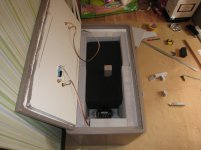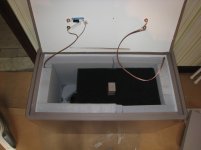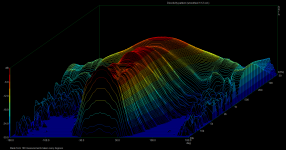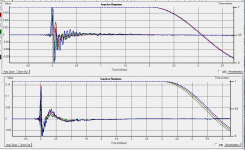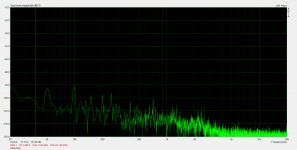I hope you can figure it out, because I have no idea. I can only help by taking additional measurements if required
Could it just be the fact that you asked to rotate around the middle of the loudspeaker? This is a very deep loudspeaker (50 cm), so the distance between microphone and speaker varies from 1.5m to 2m when going from zero to 180 degrees...
Hi _wim_
The problem that I am having with what you did before is this statement that you made, which caught me at the time, but I did not mention it.
It somehow seems unreasonable to me to plot data every degree (180 measurements)and not see any difference with data plotted using only 14 measurements. Should we not expect to see fairly large differences? Bolserst showed fairly large differences in http://www.diyaudio.com/forums/multi-way/261616-measurement-technology-9.html#post4055415 just going from 2 degrees to 10. But your data does not show any. I would expect there to be some significant differences.
Could you post a photo of the DUT so that I can see what it is you are measuring. Maybe that will help me to understand why what you get is unlike anything else that I have ever seen.
The problem that I am having with what you did before is this statement that you made, which caught me at the time, but I did not mention it.
I think my previous measurement (with 179 measurement angles) clearly shows you do a very good job in your software. The difference between the 14 measurement polar is almost nothing (and absolutely nothing more to learn from the data)
It somehow seems unreasonable to me to plot data every degree (180 measurements)and not see any difference with data plotted using only 14 measurements. Should we not expect to see fairly large differences? Bolserst showed fairly large differences in http://www.diyaudio.com/forums/multi-way/261616-measurement-technology-9.html#post4055415 just going from 2 degrees to 10. But your data does not show any. I would expect there to be some significant differences.
Could you post a photo of the DUT so that I can see what it is you are measuring. Maybe that will help me to understand why what you get is unlike anything else that I have ever seen.
Hi _wim_
The problem that I am having with what you did before is this statement that you made, which caught me at the time, but I did not mention it.
It somehow seems unreasonable to me to plot data every degree (180 measurements)and not see any difference with data plotted using only 14 measurements. Should we not expect to see fairly large differences? Bolserst showed fairly large differences in http://www.diyaudio.com/forums/multi-way/261616-measurement-technology-9.html#post4055415 just going from 2 degrees to 10. But your data does not show any. I would expect there to be some significant differences.
Could you post a photo of the DUT so that I can see what it is you are measuring. Maybe that will help me to understand why what you get is unlike anything else that I have ever seen.
I think it is going to look familiar...
Attachments
Could it just be the fact that you asked to rotate around the middle of the loudspeaker? This is a very deep loudspeaker (50 cm), so the distance between microphone and speaker varies from 1.5m to 2m when going from zero to 180 degrees...
Let me get this straight. The box is 100 liters, and 1/2 meter long, doesn't that imply a face area that is smaller than the driver area. Something is not adding up here. It is a direct radiating driver I hope. Otherwise all bets are off and you should have made that clear in the beginning.
I think it is going to look familiar...
And you are measuring this whole system, or just the top part?
The whole system would not work very well as that is very far from what is assumed.
I also cannot see how you could fit that between your floor and ceiling and get 4.3 ms. of clean response.
No there should not be any "lobes" in that design. If you measure just the top part then we know very well what we should get.
With the bottom part I am not sure.
Last edited:
Let me get this straight. The box is 100 liters, and 1/2 meter long, doesn't that imply a face area that is smaller than the driver area. Something is not adding up here. It is a direct radiating driver I hope. Otherwise all bets are off and you should have made that clear in the beginning.
Baffle width: 40 cm
Depth of speaker: 50 cm
Heigth of speaker: 70 cm
=> Volume outside = 140 liter.
Speaker is made from 2 layers of MDF with damping material in between (one reason why I do not like to lift it onto my speaker stand) => approximate internal dimensions 35x45x65 => 102 liter
Speaker is completely closed, see pictures during construction
Attachments
And you are measuring this whole system, or just the top part?
The whole system would not work very well as that is very far from what is assumed.
I also cannot see how you could fit that between your floor and ceiling and get 4.3 ms. of clean response.
No there should not be any "lobes" in that design. If you measure just the top part then we know very well what we should get.
With the bottom part I am not sure.
I am measuring just the top part. The subs are switched off during the measurement
I am measuring just the top part. The subs are switched off during the measurement
But the subs are present?
The volume should be the external volume not the internal one. The waveguide is clearly mine as I know that mounting plate, so we know exactly how that should work - I have measured hundreds of those. So something in your measurement setup is causing some errors OR and this is very possible, the match at the waveguide to the driver is not done correctly. This could cause some significant modes to propagate.
As I asked before, is the speaker centered between the floor and ceiling? Where would this center line fall on the two way when you did the measurements?
But the subs are present?
The volume should be the external volume not the internal one. The waveguide is clearly mine as I know that mounting plate, so we know exactly how that should work - I have measured hundreds of those. So something in your measurement setup is causing some errors OR and this is very possible, the match at the waveguide to the driver is not done correctly. This could cause some significant modes to propagate.
As I asked before, is the speaker centered between the floor and ceiling? Where would this center line fall on the two way when you did the measurements?
Center of speaker (so exactly in the middle between woofer and waveguide) is at 125 cm to maximise gate length.
Attached is the waterfall polar plot (which does not use any interpolation and with smoothing 1/12 oct) from the 180 measurements I took. You can clearly see in this data (and in the frequency responses I plotted in post http://www.diyaudio.com/forums/multi-way/261616-measurement-technology-7.html#post4055161) that no lobing is present. So somehow the difference must come from the fact your plot was measured with HolmImpulse, or the way the data is processed by your application.
Attachments
Last edited:
_wim_
Below is the impulse response from my speaker and yours with, I believe, identical waveguides.
You impulse are pretty noisy, especially above 1 ms compared to mine. These are the same locations etc.
We are just not getting the same results from basically the same thing. The Holm data does not look good in your case, I agree with that. Your Holm responses are 50 dB down. Do you know why that is? That is kind of in the noise floor.
My data is on the bottom
Below is the impulse response from my speaker and yours with, I believe, identical waveguides.
You impulse are pretty noisy, especially above 1 ms compared to mine. These are the same locations etc.
We are just not getting the same results from basically the same thing. The Holm data does not look good in your case, I agree with that. Your Holm responses are 50 dB down. Do you know why that is? That is kind of in the noise floor.
My data is on the bottom
Attachments
_wim_
Below is the impulse response from my speaker and yours with, I believe, identical waveguides.
You impulse are pretty noisy, especially above 1 ms compared to mine. These are the same locations etc.
We are just not getting the same results from basically the same thing. The Holm data does not look good in your case, I agree with that. Your Holm responses are 50 dB down. Do you know why that is? That is kind of in the noise floor.
My data is on the bottom
=> Difference in impulse responce: I think this is because the impulse is more compact (compare the time scales) in my case (advantage of digital crossover vs passive crossover...)
=> 50 dB down is because of mic preamp I use (micro-tech gefell), but noise floor is down to -100 db when it is quit is my living room (see measurement I just took)
Attachments
You may be below the acoustic noise floor and the electrical noise floor, but what about the numerical noise in the calculations. This could be a problem. Since the data is transferred in a limited number of digits you are throwing away at least the last four, maybe five when compared to exporting a signal closer to 0 dB. I don't know if this is a problem, but my calculations are extensive and round off could be a problem.
You may be below the acoustic noise floor and the electrical noise floor, but what about the numerical noise in the calculations. This could be a problem. Since the data is transferred in a limited number of digits you are throwing away at least the last four, maybe five when compared to exporting a signal closer to 0 dB. I don't know if this is a problem, but my calculations are extensive and round off could be a problem.
I have somewhere a battery powered pre-amp for my measurement mike with higher gain, I will see if I can repeat the holm measurements with this one... (will take minimum a couple of days before I get the chance to do this). If any other test needs to be run, now is the time, because it always nice to be able to combine tests...
I also do not understand why your impulse delay so much more than mine. It may be that I rotate a little more about the woofer magnet, about 6 inches (sorry about 15 cm) back from the speakers face than the exact center of the enclosure. But this is not really all that different.
Is there a lip sticking out from your turn table at the front when you do the measurements? I try and avoid that even if I am not rotating about the center. But if your platform is very large then there wouldn't be a good option. A large lip would cause a small reflection that could be a problem.
No hurry with the data. Microsoft is still baffled by my problem even after uninstalling and reinstalling everything (the catch all solution, but it didn't work!). Until this problem gets solved I can post anything anyways.
Is there a lip sticking out from your turn table at the front when you do the measurements? I try and avoid that even if I am not rotating about the center. But if your platform is very large then there wouldn't be a good option. A large lip would cause a small reflection that could be a problem.
No hurry with the data. Microsoft is still baffled by my problem even after uninstalling and reinstalling everything (the catch all solution, but it didn't work!). Until this problem gets solved I can post anything anyways.
He was not rude, he simply disagreed with you. Then he was polite enough to leave and start another thread. 🙂It's a shame that he couldn't have been more polite.
FWIW, I've had no trouble locking time in HOLM, either. That's across 4 different PCs and 2 operating systems. Have always used M-Audio USB sound cards, tho. (3 different models) Maybe that's what makes the difference?
He was not rude, he simply disagreed with you. Then he was polite enough to leave and start another thread. 🙂
He said:
"I also have to say that I do not like how he communicate with forum members. "
which is both rude and unnecessary since it did nothing to elucidate his argument. His comments were made even more inappropriate since what I said turned out to be correct from the beginning - he was interpolating his data.
I would welcome his presence here if he can discuss things professionally and not personally.
Not all of us see disagreement as rudeness. Different definitions of the word, I suppose.
Whateverz... it's OT anyway.
Whateverz... it's OT anyway.
....Have always used M-Audio USB sound cards, tho. (3 different models) Maybe that's what makes the difference?
Yup, the M-Audio cards are synchronous in record & play (except for a possible different start/stop time, which isn't a problem if looped). We used to recommend the M-Audio Transit for that reason (and it has no gain knobs to foul up absolute levels).
Is there a lip sticking out from your turn table at the front when you do the measurements? I try and avoid that even if I am not rotating about the center. But if your platform is very large then there wouldn't be a good option. A large lip would cause a small reflection that could be a problem.
No lip sticking out at all. Rotating mechaniscm is on the floor, and loudspeaker stand (= 2 small tables standing on each other) used has a smaller surface area then bottom of speaker (both lower table as the higer table). I have also a dedicated loudspeaker stand, but this one is a little higher (was built when I had a smaller speaker), so this would mean the center of the speaker is around 140 cm. With the 2 small tables, is at 125 cm.
- Status
- Not open for further replies.
- Home
- Loudspeakers
- Multi-Way
- Measurement technology
